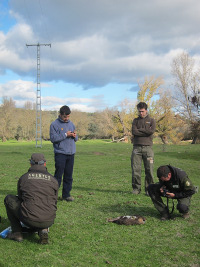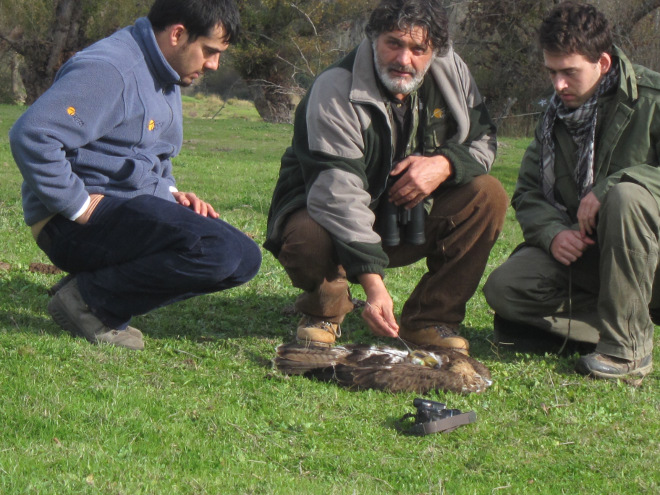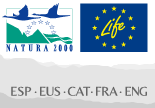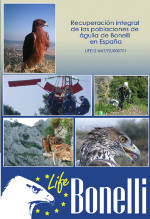
- Details
- Created: 28 November 2013
- Hits: 2034

The leading factors that brought about this sharp population decline from 1984 to 1994, were deaths caused by electrocution/collisions and hunting, along with problems derived from demographic stochasticity and population isolation. Conservation issues connected to high unnatural death rates (electrocution and hunting) have previously been tackled. However, concerns remain regarding dynamic populations that have been addressed in previous projects for which new efforts are required.
Despite the efforts carried out for the conservation of this species, doubts still exist over the lack of knowledge of each specimen’s movement. Since legal protection and the first conservation measures were developed in the 80s, other raptor species have been recovered, but the Bonelli's Eagle continues to vanish across the entire Iberian Peninsula.
To date, demographic analysis has been approached mainly from factors like productivity and mortality in each population, without lending importance to rates of immigration, emigration, recruitment, and drain and source areas.
First Problem: Issues with the metapopulation dynamics of the species.
The main problem for the reintroduction and recovery of populations is based on the concept of the metapopulation and the existing relationships between the different regions. Once the initial phases of reparation and reduction of dangers to the species are analysed, it is not possible to independently start the process of introducing birds in every region, without observing the relationship with the other regions. The sporadic nature of the species results in the movement of the birds, therefore the specimens introduced in the region may lead to a population increase in another area.
Due to the measures undertaken for conservation, adult and juvenile mortality was considerably reduced and habitat loss is momentarily under control in the areas occupied by the project. However, given the general trend of the species at the European level, the regional population (with the exception of Andalusia) has continued to decline in the past few years. This is a consequence of the biogeography of these regions in certain dispersal areas of the species and the existence of a deficit between annual reproduction and mortality rates amongst adults and juveniles in the peninsular metapopulation, which limits the philopatric flow and the ability for territorial adults to relocate (Real and Mañosa 1997, Fernandez and Azkona 2010).
The population dynamics of the Bonell's Eagle in the Iberian Peninsula and the south of France demonstrate that the populations, despite being separate, are connected through occasional phenomenons of immigration and emigration. This system has been referred to in the field of in conservation biology as “metapopulation.” Thus, the conservation measures have focused on isolated populations, without considering the role that said populations play in the metapopulation. For example, the populations of Navarre and Provence (France) are losing eagles due to the high rates of juvenile emigration migrating south and not returning in sufficient numbers because of the isolation and small size of these populations (Real and Mañosa, 1996). Moreover, high rates of sub-adult mortality have been detected, for which the only solution is an Iberian global approach (Real and Mañosa, 1996).
Consequently, the LIFE BONELLI Project aims to take on the problem from a global perspective. Monitoring the existing birds is considered to be vital (the wild species as much as those produced from captive breeding) and attempting to learn more about their movements, resolving questions such as where the Andalusian birds go that do not recolonize in former areas in other regions. Monitoring individuals and working with 5 different regions will enable us to obtain a more complete perspective of the existing relationships between the populated areas. In this way, the results are expected to determine what the natural movement of the species is and how populations behave as a whole (metapopulation). With this data, the project will identify which problems face conservation.
It is stated that the decrease in food availability has been noted as one of the causes of the decline of the species, particularly in northern regions of the specific dispersal area (northern Spain), as is the case with Navarre and Álava. This requires a greater effort in the implementation of improvement actions and habitat conservation in those areas. Moreover, progressive abandonment and depopulation is taking place in the pre-Pyrenees area of Navarre, where the main areas of the species are located in the region, and there is corresponding deterioration of the associated habitat; therefore, it is considered that a special effort is required to address this issue.
In addition to these conservation problems, it is necessary to continue working on a series of dangers and threats at a global level that have been the cause of this Bonelli's Eagle population decrease in the Iberian population. As a species that can better cope with humans than others, most areas in which they inhabit are relatively humanised, with the dangers implied by this (which will have a greater or smaller impact according to the characteristics and data from each region involved in the project).
As demanded by the IUCN regulations for the reintroduction of the species, it is essential to reduce these threats to the fullest extent in order to reintroduce the species successfully. Therefore, while in previous projects similar important work has been carried out, the BONELLI project continues to minimise the threats and dangers in order to support the population of newly reintroduced birds in target areas.
These threats are:
 Threat 1: Electrocution and collision
Threat 1: Electrocution and collision
Electrocution is attributed to the distribution of overhead cables, whereas collisions can happen on any overhead cable, as well as in wind farms near breeding areas.
This is considered to be the main cause of adult and juvenile mortality.
This threatening factor has been reduced significantly in the project areas owing to the corrective measures taken, but they should be completed or maintained.
Threat 2: Human activities of habitat homogenization
Changes to the nesting environment from habitat homogenisation caused by infrastructure and transformation of the surroundings.
The availability of potential prey is decreasing in home ranges, which may limit reproduction. This reduces the ability to find new territories, hindering the recolonization of old territories, and in extreme cases, it may mean the abandonment of breeding areas.
Threat 3: Human threats to nesting areas
Associated with recreational activities (hiking, adventure sports such as rock-climbing or canyoning, photography, tourism, etc.) and practical activities (quarries, farming, infrastructure, etc.). It is one of the main causes of failures in reproduction. This threat has increased due to the rise of invasive sports. At the core of this project, there will be a regularization of leisure and free time activities in former territories of the Bonelli's Eagle to support its recolonization.
Threat 4: Natural deterioration of the habitat
In general, it is necessary to remember that the Bonelli's Eagle is a Mediterranean species living in the western Palearctic zone. Rupicola and thermophiles inhabit Mediterranean habitats. Álava and Navarre are both located in the bioclimatic boundary of the Mediterranean region in the Iberian Peninsula and therefore, there are fewer habitats of this type available.
This deterioration of habitat also reduces the availability of potential prey in inhabited areas, which may limit reproduction. This reduces the ability to find new territories, hindering the recolonization of old territories, and in extreme cases, it may mean the abandonment of breeding areas. According to the data available on behalf of the Ministry of Agriculture, Food and Environment, the rabbit population density in Navarre and the Basque Country display some of the lowest values.
Therefore, the improvement in habitat by means of increasing prey populations is a high-priority action in the northern regions, whereas it is not considered in the more Mediterranean communities (Madrid and Balearic Islands).
Threat 5: Illegal hunting and direct persecution
Broadly associated with hunting activities. Hunting has become less and less important, but cases continue to be reported involving deaths by shooting and poisoning, associated with the bad reputation of raptors, although this is changing in society. In Mallorca, the extinction of the species was directly linked to hunting. Indirectly, adult mortality causes a significant decrease in potential reproduction.
Although it is an illegal activity and thus difficult to assess, this is ranked second in causes of adult and juvenile mortality.





















